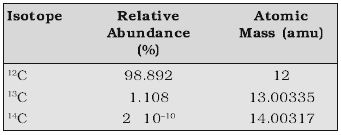Average Atomic Mass: Many naturally occurring elements exist as more than one isotope. When we take into account the existence of these isotopes and their relative abundance (per cent occurrence), the average atomic mass of that element can be computed.
For example, carbon has the following three isotopes with relative abundances and masses as shown against each of them.

From the above data, the average atomic mass of carbon will come out to be:
(0.98892) (12 u) + (0.01108) (13.00335 u) + (2 x 10-12)(14.00317u) = 12.011 u.
Similarly, average atomic masses for other elements can be calculated. In the periodic table of elements, the atomic masses mentioned for different elements actually represented their average atomic masses.












